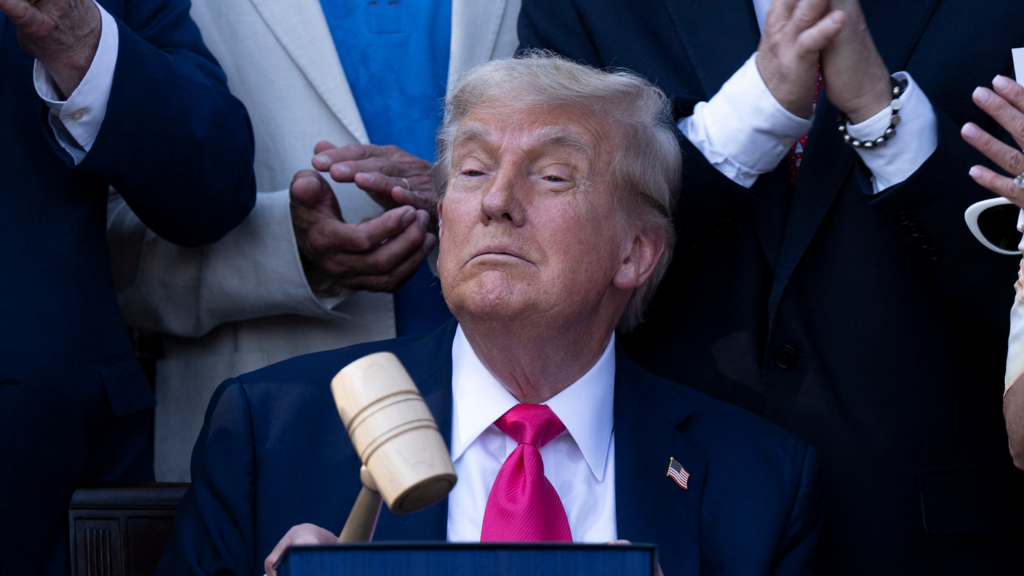“`html
As Donald Trump lauded the passage of what he has dubbed the “Big Beautiful Budget Bill” through Congress this week, longstanding concerns regarding the scale and sustainability of U.S. borrowing from international sources have resurfaced.
The approved tax-cutting budget bill is projected to add at least $3 trillion to the U.S.’s already substantial $37 trillion debt. Critics of the plan are numerous, including Elon Musk, a former ally of Trump, who has characterized it as a “disgusting abomination”.
The burgeoning debt burden raises questions about the limits of international willingness to lend to the United States.
These doubts have recently manifested in a weaker dollar and higher interest rates demanded by investors for lending to the U.S.
Such borrowing is essential to offset the difference between annual income and expenditure.
Since the beginning of this year, the dollar has depreciated by 10% against the pound and 15% against the euro.
Although overall U.S. borrowing costs have remained stable, the yield curve—the difference between interest rates on longer-term versus shorter-term loans—has steepened, indicating growing concerns about the long-term viability of U.S. borrowing.
This occurs despite the U.S. having lowered interest rates more slowly than the EU and the UK, a factor that would typically strengthen the dollar by attracting investors seeking higher interest rates on bank deposits.
Ray Dalio, founder of the world’s largest hedge fund, suggests that U.S. borrowing is at a critical juncture.
He estimates that, based on current trends, the U.S. will soon be allocating $10 trillion annually to loan and interest repayments.
“I am confident that the [US] government’s financial condition is at an inflection point because, if this is not dealt with now, the debts will build up to levels where they can’t be managed without great trauma,” he says.
What form might this “trauma” take?
One option involves a significant reduction in government spending, a substantial increase in taxes, or a combination of both.
Ray Dalio proposes that reducing the budget deficit from its current 6% to 3% could avert future problems.
While Trump’s budget bill includes some spending cuts, it also enacts larger tax cuts, steering the current political trajectory in the opposite direction.
Secondly, as in past crises, the U.S. Federal Reserve could print more money to buy up government debt, as it did following the 2008 financial crisis.
However, this could fuel inflation and exacerbate inequality, benefiting owners of assets like houses and shares more than those reliant on the value of labor.
The third possibility is a direct U.S. default. Given that the “full faith and credit of the U.S. Treasury” underpins the entire global financial system, such an event would dwarf the 2008 financial crisis.
How likely is any of this?
Currently, these scenarios remain unlikely.
However, the reasons for this are not necessarily reassuring. The reality is that the world has few viable alternatives to the dollar.
Economist Mohamed El-Erian told the BBC that while many are attempting to reduce dollar holdings, “the dollar is overweight and the world knows it, which is why we have seen a rise in gold, the euro and the pound, but it’s hard to move at scale so there’s really very few places to go”.
“The dollar is like your cleanest dirty shirt, you have to keep wearing it.”
Nevertheless, the future of the dollar and U.S. government bonds—the world’s benchmark asset—is being discussed at the highest levels.
The Governor of the Bank of England recently noted that the levels of US debt and the status of the dollar is “very much on [US Treasury] Secretary Bessent’s mind. I don’t think the dollar is fundamentally under threat at the moment but he is very aware of these issues and I don’t think it is something that he underestimates.”
A debt of $37 trillion is an immense figure. Saving a million dollars every day would require 100,000 years to accumulate that amount.
A more practical approach is to consider debt as a percentage of a country’s income. The U.S. economy generates approximately $25 trillion in annual income.
While its debt-to-income ratio is high relative to many nations, it is lower than that of Japan or Italy, and it is supported by the world’s most innovative and wealth-generating economy.
I possess a copy of William F. Rickenbacker’s “Death of the Dollar,” which cautions against risks to the dollar’s status as the world’s reserve currency. It was written in 1968. Mr. Rickenbacker is no longer alive—the dollar is.
However, this does not imply that its status and value are immutable.
A signing ceremony at the White House on Friday afternoon kicked off celebrations for 4 July.
The tax and spending bill, which is set to become law, includes sweeping changes to taxes, Social Security and more.
Trump says the fight would be part of next year’s celebration of 250 years of American independence.
The prime minister says he found common ground with President Trump as both “really care about family”.
The president wins over sparring factions within his own party to get the bill passed after months of wrangling.
“`

